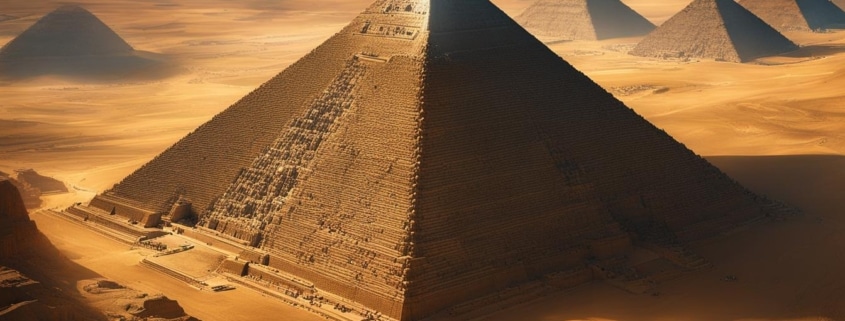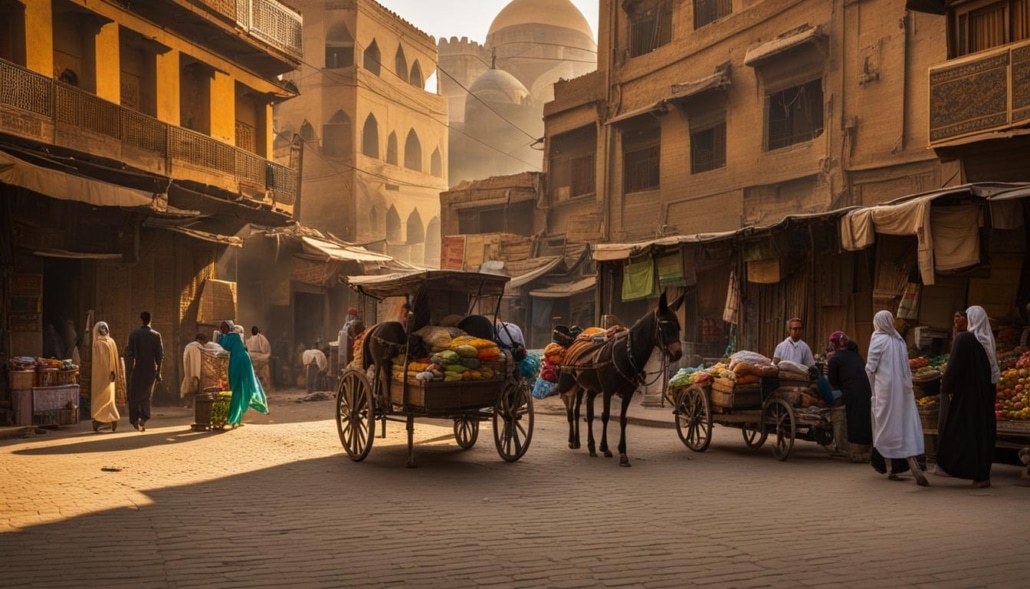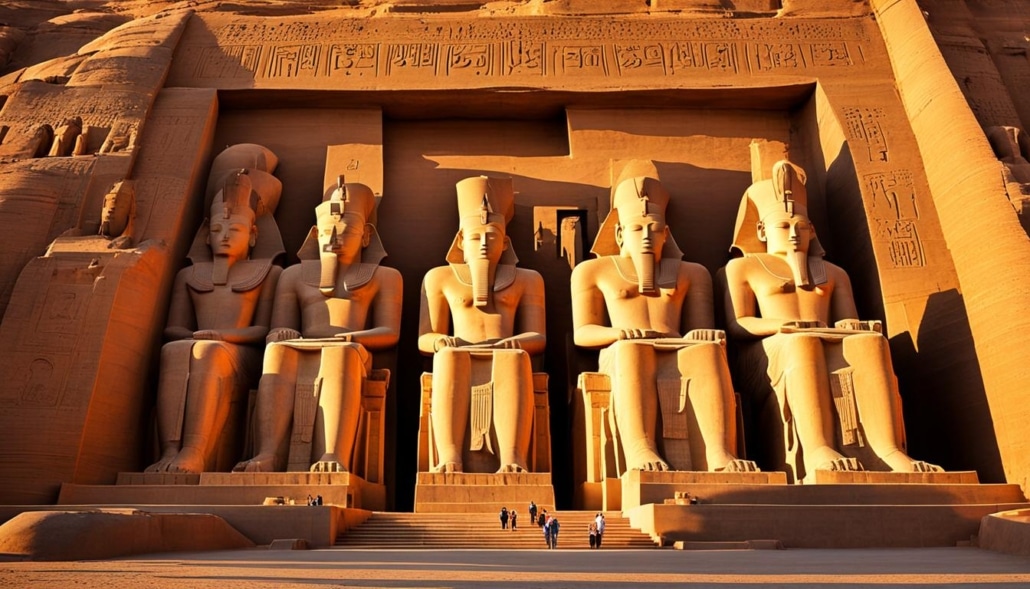Discovering the Ancient Wonders of Egypt
Egypt, known for its rich ancient civilization, is a treasure trove of ancient wonders that continue to captivate travelers from around the world. From the magnificent pyramids to the enigmatic Sphinx, Egypt offers an unparalleled journey through time. This travel guide will take you on a virtual tour of the most iconic landmarks, providing insights into the captivating history and timeless allure of Ancient Egypt. So fasten your seatbelts and get ready to explore this ancient wonderland!
The Great Pyramid of Giza
The Great Pyramid of Giza, located in the Giza Necropolis near Cairo, is the oldest and largest of the three pyramids. It is the only remaining member of the Seven Wonders of the Ancient World and was built as a tomb for the Fourth Dynasty Egyptian Pharaoh Khufu around 2560 BC.
This architectural marvel stands as a testament to the advanced engineering skills and cultural significance of ancient Egypt. Let’s explore the fascinating details of the Great Pyramid and its surrounding complex.
The Magnificent Structure
The Great Pyramid of Giza is an impressive feat of construction, built using approximately 2.3 million stone blocks, each weighing several tons. Its original height was around 481 feet (147 meters), making it the tallest man-made structure for over 3,800 years until the completion of the Lincoln Cathedral spire in England in the 14th century.
This architectural marvel showcases the precision and ingenuity of ancient Egyptian engineering. The pyramid’s sides were carefully aligned with the cardinal points of the compass, and its smooth limestone casing stones reflected the sun’s rays, giving the pyramid a brilliant shine. It is estimated that the construction of the pyramid took around 20 years to complete.
Ancient Wonder and Symbolism
The Great Pyramid of Giza holds immense historical and cultural significance. It served as the final resting place for Pharaoh Khufu, who reigned during the Old Kingdom period of ancient Egypt. The pyramid was designed to protect Khufu’s body and possessions for eternity and provide him with a luxurious afterlife.
Inside the pyramid, visitors can explore the burial chamber and various passages, including the Grand Gallery and the Descending Passage. These architectural elements highlight the Egyptians’ belief in the afterlife and the complex rituals associated with the Pharaoh’s journey to the realm of the gods.
Structural Complex
In addition to the main pyramid, the complex includes two mortuary temples, one on the east side and one on the west side. These temples were used for religious ceremonies and offerings to honor the Pharaoh. The complex also features three smaller pyramids built for Khufu’s wives, as well as other structures associated with the pyramid complex, such as the causeway and the Sphinx Temple.
| Key Facts about the Great Pyramid of Giza | |
|---|---|
| Location | Giza Necropolis, near Cairo, Egypt |
| Height | 481 feet (147 meters) |
| Construction Period | Around 20 years, completed around 2560 BC |
| Builder | Fourth Dynasty Egyptian Pharaoh Khufu |
| Significance | One of the Seven Wonders of the Ancient World |
Visiting the Great Pyramid of Giza is an awe-inspiring experience that allows travelers to witness the grandeur and mastery of ancient Egyptian civilization. It continues to captivate the imagination and intrigue researchers and enthusiasts from around the world.
The Great Sphinx
The Great Sphinx of Giza is a fascinating ancient wonder that continues to captivate visitors from around the world. This imposing statue is a testament to the remarkable craftsmanship and rich mythology of ancient Egypt.
The Great Sphinx stands proudly in the Giza Plateau, just a stone’s throw away from the majestic pyramids. This colossal statue depicts the head of a human atop the body of a lion, symbolizing strength and wisdom. Carved out of a single limestone block, the Great Sphinx is one of the largest single-stone statues on Earth.
The origins of the Great Sphinx remain shrouded in mystery, adding an air of intrigue to its already awe-inspiring presence. It is believed to have been constructed by the ancient Egyptians during the 3rd millennium BC, although the exact purpose and history of its creation are still a subject of debate among experts.
“The Great Sphinx stands as a symbol of ancient Egypt’s artistry, engineering prowess, and enigmatic mythology.”
One theory suggests that the Great Sphinx represents the pharaoh Khafra, whose pyramid is nearby. Another theory proposes that it embodies the sun god Ra, a prominent figure in Egyptian mythology. Regardless of its true identity, the Great Sphinx has undoubtedly played a significant role in Egyptian culture and continues to inspire wonder and curiosity.
The Mysteries of the Great Sphinx
The Great Sphinx holds many secrets waiting to be unraveled. Its temple, located between its paws, is believed to conceal hidden chambers that may hold clues to its purpose and significance in ancient times. Excavations and ongoing research aim to shed light on these mysteries and provide a deeper understanding of this iconic monument.
The Great Sphinx in Popular Culture
Over the centuries, the Great Sphinx has not only fascinated archeologists and historians but also served as a muse for countless artists, writers, and filmmakers. Its enigmatic allure has been featured in numerous movies, novels, and artworks, cementing its status as an iconic symbol of ancient Egypt.
Visiting the Great Sphinx
To experience the grandeur of the Great Sphinx firsthand, visitors can explore the Giza Plateau and witness this incredible monument up close. Walking in the presence of this ancient wonder is a humbling experience that allows you to immerse yourself in the vibrant history and mythological significance of ancient Egypt.
| Key Facts about the Great Sphinx | |
|---|---|
| Location | Giza Plateau, near Cairo, Egypt |
| Date of Construction | Approximately 3rd millennium BC |
| Materials | Limestone |
| Measurements | Height: 66 feet (20 meters) |
| Length: 240 feet (73 meters) | |
| Width: 62 feet (19 meters) |
The Temple of Luxor
The Temple of Luxor, located in the city of Luxor, is one of the most magnificent ancient wonders of Egypt. This majestic temple was dedicated to the Theban Triad of Amun-Re, Mut, and Khonsu, and it played a central role in the religious and ceremonial life of ancient Egypt.
Constructed by pharaohs Amenhotep III and Ramesses II, the Temple of Luxor is a testament to the grandeur and architectural mastery of the ancient Egyptians. The temple complex boasts impressive structures, intricate carvings, and stunning reliefs that depict the ancient Egyptian rituals and ceremonies.
The beautiful hieroglyphs and wall carvings provide a fascinating glimpse into the religious practices and beliefs of ancient Egypt. These intricate details showcase the elaborate rituals and offerings made to the gods and goddesses, offering us profound insights into the spiritual world of the ancient Egyptians.
The Temple of Luxor is a fascinating testament to the rich religious heritage and cultural legacy of ancient Egypt. Its grand architecture and intricate reliefs enchant visitors, transporting them back in time to experience the ancient Egyptian rituals and traditions.
This sacred temple not only served as a place of worship but also as a venue for important festivals and celebrations. It was during these occasions that the ancient Egyptians would come together to honor and connect with their gods through elaborate ceremonies and processions.
The Temple of Luxor stands as a testament to the power, devotion, and architectural genius of the ancient Egyptians. Its grandeur and intricate details continue to captivate visitors from around the world, offering a unique opportunity to immerse oneself in the ancient wonders of Egypt.
Experience the awe-inspiring beauty and profound spirituality of the Temple of Luxor, immersing yourself in the rituals and traditions of ancient Egypt.
| Key Features of the Temple of Luxor | Significance |
|---|---|
| Avenue of Sphinxes | A grand processional route that connected the Temple of Luxor with the Karnak Temple Complex |
| Obelisks | The temple originally had two, but one of them now stands in the Place de la Concorde in Paris |
| Hypostyle Hall | A massive hall with towering columns adorned with intricate carvings and hieroglyphs |
| Colonnade Court | A spacious courtyard with beautifully decorated columns offering a tranquil space for reflection |
| Akhenaten’s Shrine | A small chapel dedicated to Akhenaten, the pharaoh known for introducing a monotheistic religion during his reign |
Cairo
Cairo, the capital city of Egypt, is a vibrant metropolis with a rich history. It has a population of over 15 million people and is known for its historic landmarks such as the Pyramids of Giza, the Sphinx, the Citadel, the Hanging Church, and the Egyptian Museum. Cairo is a city that seamlessly blends ancient Egyptian history with modern urban life.
As the capital city of Egypt, Cairo serves as a gateway to the country’s ancient wonders and offers a fascinating glimpse into the ancient Egyptian civilization. With its bustling streets, vibrant markets, and architectural marvels, Cairo embodies the unique fusion of tradition and modernity.
The Pyramids of Giza, one of the Seven Wonders of the Ancient World, stand majestically on the outskirts of Cairo. These ancient structures, built thousands of years ago, are a testament to the incredible engineering skills of the ancient Egyptians. Visitors can explore the Great Pyramid of Khufu, the Pyramid of Khafre, and the Pyramid of Menkaure, each shrouded in mystery and awe.
The Great Sphinx, another iconic symbol of ancient Egypt, is located near the Pyramids of Giza. This enigmatic statue, with the body of a lion and the head of a pharaoh, has captured the imagination of people for centuries. It is believed to have guarded the pyramids and served as a protective deity.
The Citadel of Cairo, a medieval Islamic fortress, dominates the city’s skyline. Built by the Ayyubid dynasty in the 12th century, it offers panoramic views of Cairo and houses several historic mosques, including the famous Muhammad Ali Mosque.
The Hanging Church, also known as the Church of St. Virgin Mary, is a significant Coptic Orthodox church in Cairo. It is one of the oldest churches in Egypt and is famous for its unique architectural design, with its nave suspended over the gatehouse.
The Egyptian Museum, located in Tahrir Square, is a treasure trove of ancient artifacts, including the world-renowned collection of Tutankhamun’s treasures. Visitors can marvel at countless artifacts that span thousands of years of ancient Egyptian history, providing invaluable insights into its culture and civilization.
“Cairo is a city that breathes history. From the majestic pyramids to the bustling streets, every corner tells a story of ancient Egyptian civilization. It’s a place where the past and the present coexist, offering a unique experience for travelers.”
Top Landmarks in Cairo
| Landmark | Description |
|---|---|
| Pyramids of Giza | Home to the iconic Great Pyramid, a testament to ancient Egyptian engineering prowess. |
| The Sphinx | An enigmatic statue believed to be associated with pharaohs and protective deities. |
| The Citadel | A medieval fortress offering stunning views of Cairo and housing historic mosques. |
| Hanging Church | Oldest church in Egypt known for its suspended nave and Coptic religious significance. |
| Egyptian Museum | Treasure trove of ancient artifacts, including the famous Tutankhamun collection. |
Exploring Cairo is like embarking on a journey through time, where the ancient past meets the modern present. Immerse yourself in the captivating blend of ancient Egyptian history and the vibrant energy of a bustling capital city.
Abu Simbel Temples
The Abu Simbel Temples are two magnificent rock temples located in southern Egypt. These awe-inspiring structures were carved into the mountainside during the reign of Pharaoh Ramesses II, also known as Ramesses the Great, who ruled during the 13th century BC.
Dedicated to the gods Amun Ra, Ra Harakhti, and Ptah, the Abu Simbel Temples are considered among Egypt’s most remarkable ancient wonders. These temples were created not only as a symbol of the pharaoh’s power and devotion but also to honor the gods and their role in ancient Egyptian mythology.
In the 1960s, a massive temple relocation project was undertaken to save the Abu Simbel Temples from being submerged by the rising waters of the Nile due to the construction of the Aswan High Dam. The entire complex, weighing around 40,000 tons, was meticulously dismantled and moved to a higher location, preserving these incredible structures for future generations to appreciate.
The temples themselves are a testament to ancient Egyptian architectural mastery. They feature impressive statues of the pharaoh, intricate inscriptions, and stunning reliefs depicting historical and religious scenes. The sheer scale and intricate details of the Abu Simbel Temples continue to astound visitors from around the world, offering a glimpse into the grandeur of ancient Egypt.
The Abu Simbel Temples stand as a testament to the skill, devotion, and ingenuity of the ancient Egyptians. Their relocation is a testament to modern engineering marvels. Visiting these temples is a journey back in time, where you can’t help but marvel at the achievements of the past and the legacy they leave behind.
Conclusion
Exploring the ancient wonders of Egypt is like embarking on a journey through time to a civilization that has left an indelible mark on human history. With its famous pyramids, magnificent temples, and bustling capital city of Cairo, Egypt is a treasure trove of captivating experiences for travelers.
Begin your adventure by marveling at the iconic pyramids of Giza, including the Great Pyramid, the last remaining wonder of the ancient world. These towering structures stand as testaments to the ingenuity and craftsmanship of the ancient Egyptians.
Continue your exploration with a visit to the impressive Temple of Luxor, where you can witness the grandeur of ancient Egyptian rituals and immerse yourself in the religious traditions of the time. The temple’s intricate architecture and captivating reliefs will transport you back to an era of awe-inspiring devotion.
Don’t miss the chance to explore the bustling city of Cairo, where the past and present coexist harmoniously. Wander through the streets of this vibrant metropolis and discover its historic landmarks, such as the enigmatic Sphinx, the majestic Citadel, and the fascinating Egyptian Museum, home to countless ancient artifacts.
In your journey through Ancient Egypt, a visit to the Abu Simbel Temples is a must. These monumental temples, relocated to save them from the rising waters of the Nile, showcase the architectural prowess of the ancient Egyptians and are a testament to their deep religious beliefs and reverence for their gods.
In conclusion, Ancient Egypt offers an unparalleled travel experience for those seeking to unravel the mysteries of the past. Immerse yourself in the wonders of this extraordinary civilization, and let the ancient monuments and rich history of Egypt captivate your imagination.
FAQ
What are some of the ancient wonders of Egypt?
Egypt is home to a wealth of ancient wonders, including the Great Pyramid of Giza, the Great Sphinx, the Temple of Luxor, and the Abu Simbel Temples.
Where is the Great Pyramid of Giza located?
The Great Pyramid of Giza is located in the Giza Necropolis near Cairo, Egypt.
Who was the Great Pyramid of Giza built for?
The Great Pyramid of Giza was built as a tomb for the Fourth Dynasty Egyptian Pharaoh Khufu.
What is the significance of the Great Sphinx?
The Great Sphinx is believed to have been built by ancient Egyptians in the 3rd millennium BC. It represents either the pharaoh Khafra or the sun god Ra.
What is the Temple of Luxor known for?
The Temple of Luxor, located in the city of Luxor, is known for its grand architecture and reliefs depicting ancient Egyptian rituals. It was dedicated to the Theban Triad of Amun-Re, Mut, and Khonsu.
What are some famous landmarks in Cairo?
Cairo, the capital city of Egypt, is known for its historic landmarks such as the Pyramids of Giza, the Sphinx, the Citadel, the Hanging Church, and the Egyptian Museum.
What are the Abu Simbel Temples?
The Abu Simbel Temples are two massive rock temples carved into the mountainside. They were built during the reign of Pharaoh Ramesses II and were dedicated to the gods Amun Ra, Ra Harakhti, and Ptah. The temples were relocated in the 1960s to avoid being submerged by the Aswan High Dam.
Why should I visit the ancient wonders of Egypt?
Exploring the ancient wonders of Egypt is like stepping back in time to an extraordinary civilization that left behind lasting monuments and a captivating history. It offers a unique and unforgettable travel experience that allows you to immerse yourself in its timeless wonders.






Leave a Reply
Want to join the discussion?Feel free to contribute!